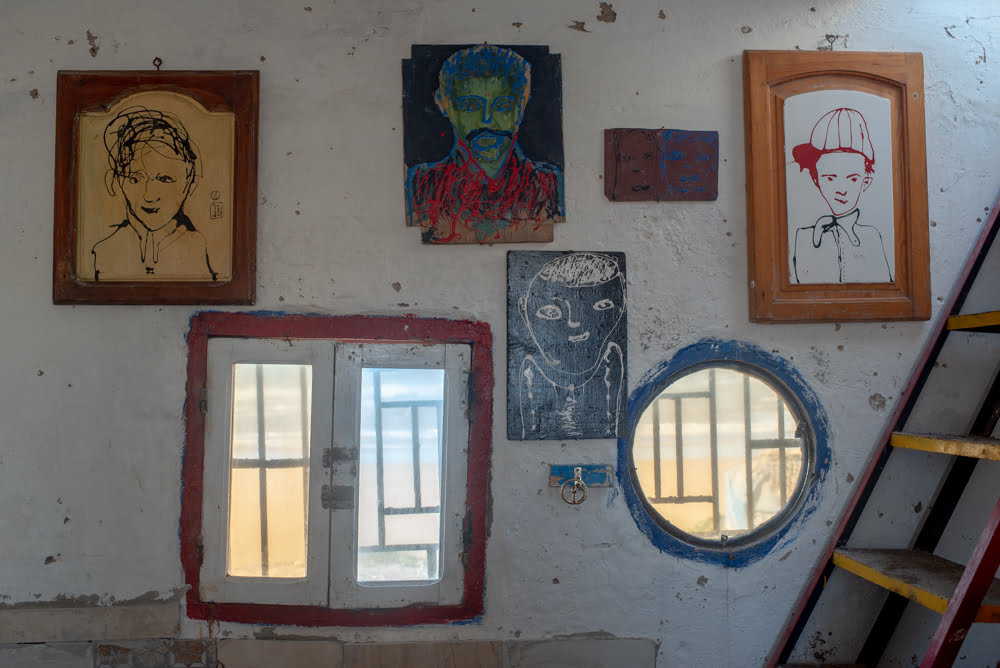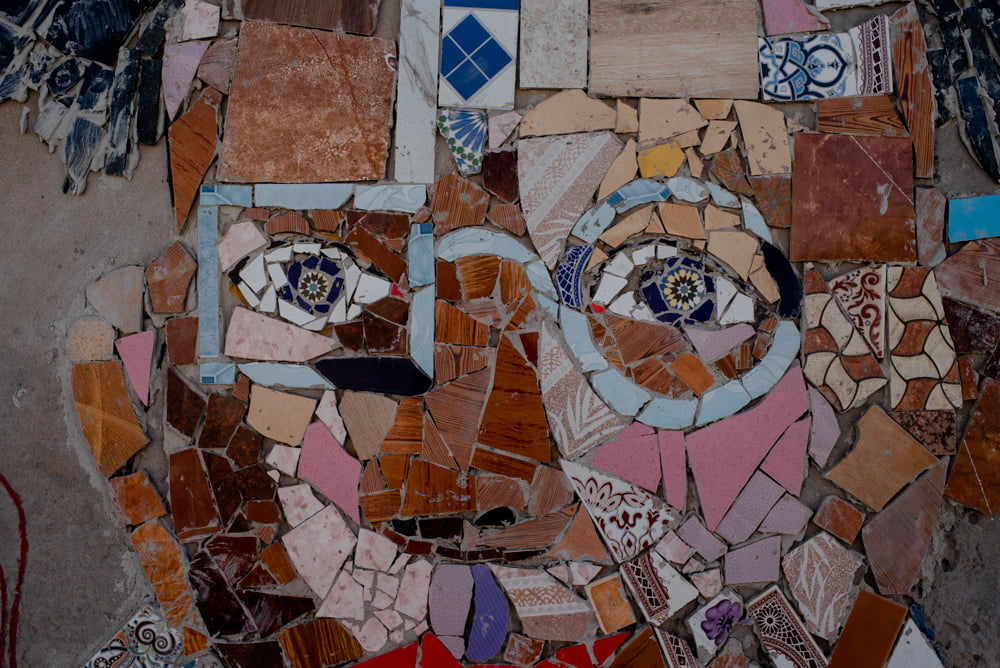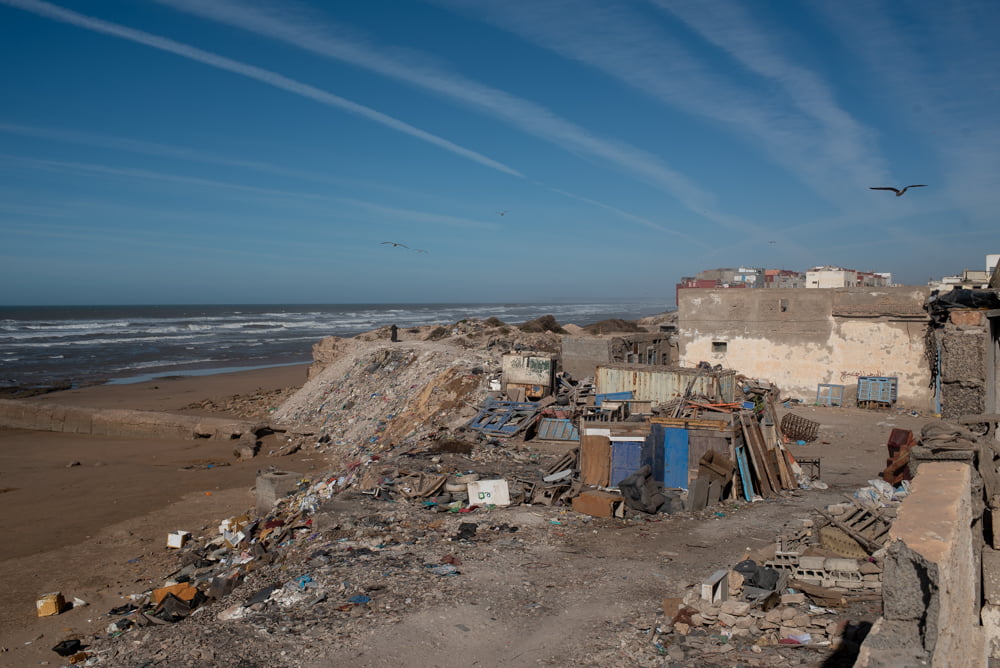The artist’s studio overlooking the swell of the Atlantic ocean one mile north of Bab Doukalla, Essaouira, is just one part of an idiosyncratic and quietly eccentric art installation which stretches across the world. The installation has been gradually developed and nurtured over the last 15 years and, although now international, its central heartland resolutely remains in France, its other locations co-connected for long periods by the modernity of video and internet.
The installation is quite unique; it is an imaginary and borderless city.
Its physical locations have included the art deco Piscine Molitor in Paris and the old artist’s squat at 24 Cour des Petites Ecuries, followed by an oyster farm on the Île-de-Ré, an island off the west coast of France. It subsequently moved to a chateau in Burgundy. A “factory” was located in an abandoned tannery in the Moroccan city of Essaouira and closed several years ago to be replaced by the current studio outlet. A housing project in New York continues to link into the virtual network. Travelling installations in Seville, Dubai, Shanghai and Ibiza followed.
When the installation moves to a new location, drawings, installations and films that tell the story and current developments of Flateurville are transferred as well.
The brainchild of this pageant is French artist, writer and film maker Laurent Godard, now aged 51. He has carefully evolved a dynamic city that has its own flag, citizens, stories and myths and is a place of revolution, of drug trafficking, of prisons, of murder. It has its own artist, called Marcel, who paints portraits of all its citizen then hangs them in his Warehouse for display. It has its own national drug, the addictive Fleur Bleue. It has a design that recurs ubiquitously throughout the Flateurville landscape; a square and a circle close together. This motif has been fashioned into multiple creations including idiosyncratic spectacles, is prominent on the city’s flag and can be seen on most of the artwork, especially around the eyes of portraits and sculpture. It has a social and political unifying role.
The whole is a peculiarly French creation, with a quiet subtle humour and surreal idealised reality, and demonstrates a quirky but charmingly subversive quality in the same vein as French auteur Jean-Pierre Juenet in films such as Delicatessen.
Godard has explained that “In Flateurville there rules a corrupt, militaristic power; the misery of the world is focused here“. But the community, united under the common insignia: the square and the circle, considers revolution to fight back. “The square, the rigorous, stands for living space, for health and justice. The circle, the gentle, symbolizes the mind, artistic creation, spirituality.”
Around this scenario unfolds a whole narrative complete with original characters and exciting adventures.
Its diverse characters include Susan, a female painter who returned to Flateurville after an absence of 25 years, Marcellin, the son of artist Marcel, Georges, a cosmetic surgeon, and his son P’tit Louis who has an impossible love for Susan, Mouss, the small gypsy, Carine the Shériff despotique of the city. Francine Bouffier helps citizens reduce their dependency on the Fleur Bleue, a drug which causes serious mouth and throat illnesses. With the help of dentures, she manages “to give them back their smiles sometimes”.
The heart of the virtual community now resides quietly in Auxerre, the fourth largest city in Burgundy, occupying a former paint factory on the banks of the river Yonne. Here everything is displayed: writing, music, sculpture and painting. The portraits are always of the inhabitants of the village and fill 3,000 square meters of this old factory space; portraits of fictional characters who inhabit a cyber world staring at each other. Here Flateurville can be visited, explored and enjoyed but currently only by members who have subscribed into its club. Its peripheral satellites in Essaouira and New York continue to exist and be open to the public; solid portals into the virtual world.
Flauterville’s studio in Essaouira is on the edge of the Jotiya, a large flea market where discarded items and flotsam washed up by the sea are recycled and traded. Surrounded by other artists and their studios, it is Flateurville which announces it presence the loudest. It is managed jointly by Mohammed and Wafaa, both artists, and has been open for 4 years. The studio is stocked with Marcel’s paintings as well as work from both Mohammed and Wafaa. Wafaa tells me that Laurent Godard was actually visiting Essaouira that day. He and Mohammed were discussing the creation of an installation on the roof of the studio upon which Mohammed’s son was already preparing a frame with wood and mortar.
From the roof terrace, where the iconic square and circle looks out over the neighbourhood, the view over both the Jotiya and the coastline is spectacular.
In the studio Wafaa points out Goddard’s ( of course who is secretly Marcel Martin ) paintings as well as Mohammed’s and her own. She points to a large portrait of her made by Godard; it, like all of Marcel/Godard’s work, betrays the ‘dripping’ technique inspired by Jackson Pollock where the paintbrush rarely touches the canvas. In the studio there are documents and hand outs which provide information both about the Essaouira location as well as the other parts of the network and substantial information on Flateurville’s history.
Outside on an adjacent wall a large colourful ceramic portrait has been assembled from discarded tiles, the tell-tale square and round spectacles fashioned in the ceramics is the only clue it is from and depicts a fictional world. A tiled pathway from this artwork leads to the studio and the collection of Flateurville works inside where two windows, in close proximity, one a circle and the other a square, looks out over the Atlantic waves and the perpetually blue sky. Outside, on the reverse of that same wall and beside the foreshore and beach, another large portrait has been created where the eyes, one square and the other round, are the same windows which look out from inside the studio. A metal cage ensures safety and security.
The afternoon passes and I hope that the creator of Flateurville Laurent Godard might return and it might be possible for me to meet him. I find a table top with the square and the round motif discarded on the foreshore, forming a part of a small boundary at the edge of the Jotiya flea market. Wafaa laughs and explains it was their old bureau. The virtual world enters the real world unexpectedly, almost like a tirtha, or a fording of dimensions.
Laurent Godard does not return and as dusk falls large dogs prowl around the locality. I take one last look at the tiled facade of Flateurville staring out towards the sea, the ceramics and metal cage and the two different shaped windows. I try to imagine Flateurville’s characters and their struggle for a more just world. Beside the installation the coast path begins its way back to Essaouira.
I walk back to another world through the jumble of Jotiya.
Further information can be found about Flateurville on Facebook
A recent article describing the factory in Auxerre is here
Information regarding the satellite at Essaouira is here
Information regarding Flateurville and its installation at the iconic art deco Piscine Molitor is here
.









